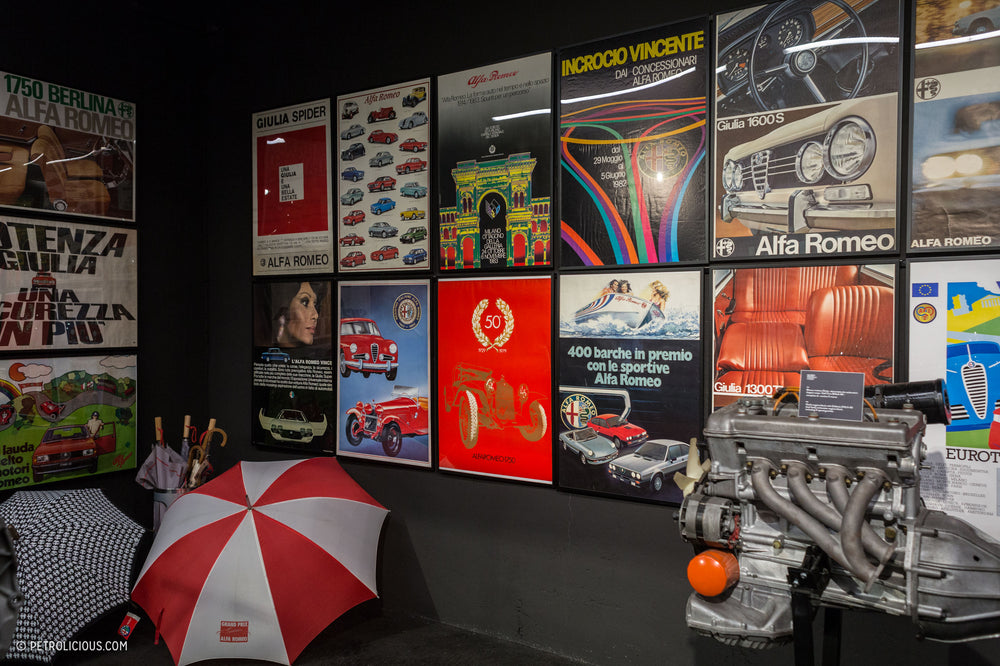It’s no deep secret that I’m fond of Alfa Romeos, and I doubt I’ll ever become jaded to the point that an invitation to see a another collection of them falls on deaf ears. I’m always intrigued by the prospect of more of what I love, so when a friend told me about a special place located on the outskirts of Milan wherein a single family has curated a unique museum underneath a modern car dealership, I wasn’t about to visit "next time.”




Taking a short trip northwest of the city center to the small town of Legnano, I am met by the glass walls of a showroom filled with contemporary FCA products as the navigation informs me that I’ve arrived—well, close to it anyway. Before I laid eyes on anything more than a few model years old, I was introduced to the museum curators on the main floor to talk for a few minutes about the provenance of the place before venturing through the beckoning red door hidden away in the corner. A neon sign reading “Museo Fratelli Cozzi” hung above the subtle insignia of Alfa Romeo is the only hint at the contrast between the main floor and the history socked away below ground. Descending the staircase leads to a somewhat jarring transition between the clean-cut modernity I’d left behind and the far moodier space I’d stepped into.




Pietro Cozzi has been amassing this collection of Alfas and automobilia since he was 19 years old, and he’s now joined in his efforts by his daughter Elisabetta. Long before she was born though, Pietro approached his own father for a loan. A car-obsessed teenager asking to borrow money from his parents? Typically that’s an insurance claim waiting to happen and involving a bent sports car in a ditch, but this was a rare case of adolescent responsibility when it came to young men and fun cars, and by 1955 Pietro Cozzi had opened up his own Alfa Romeo dealership.




His operation was modest, but his timing was fantastic. The mid-‘50s are seen as somewhat of a renaissance for the marque, and rightly so. Alfa was entering a new era in its timeline, refreshing itself after the war you might say. It was much more than a passive ride on the economic updraft though, for the then-new Giulietta was signaling great things for the brand’s future while building a tidy profit and fanbase in the process. The Giulietta that was first seen in its hardtop Sprint guise led to a roster of other Giulietta variants that spanned practical sedans like the Berlina to the sculptural Sprint Speciales bodied by Bertone. Joined by the lovable Spider the Giulietta series had the bases all but covered, and the sales numbers reflected the appeal of the rejuvenated Alfa lineup.





So what does this have to do with the museum? As Pietro ran his business over the ensuing decades, he would occasionally keep a car or two for himself, along with pieces of literature and artwork related to or commissioned by Alfa. He wasn’t taking new cars off the floor to put in his garage though. Like any genuine enthusiast, his automotive wish list was well populated with the specialty stuff, so whenever something came back from a former client on a trade in or some such situation, he’d keep their older cars for himself if he was interested in them. Today the collection of cars is approaching the 100 mark, and though it isn’t the largest nor most exotic assemblage of Alfas in the world, I believe anyone interested in the marque should make note of it.









The why doesn’t lie in the metal or fiberglass alone though; it’s hung on the walls and stacked on the shelves. See, this is a very unique museum in the sense that it can be traced back to 1955 for one thing, but add the fact that Pietro was connected with the factory through his profession and you get the best ingredients for any museum: history and rarity. History in the sense that Pietro’s been collecting this stuff since he was a kid, and rarity in the sense that much of it was never available to the public. That means he has the factory’s schematics and other internal documents, prototype drawings, one-off models and rare artwork, trophies and sketches and anecdotal photographs and vintage neon and all manner of items that are somehow infinitely more compelling than a collection of priceless cars. For instance, Pietro has a collection of loose 8”x10” black and white photographs portraying influential people in the company of Alfa Romeos. Among others, you’ve got the Beatles exiting the open door of a Furgone van; an early form of celebrity promotional materials that reminds one of today’s “Instagram influencer” style of advertising.





I’m still struck but the depth of content Pietro and Elisabetta share with the museum’s visitors, and for someone like me with an infatuation for Italian automobilia there’s really nothing else like this. It’s so much more than a novel supplement to the factory museum in Arese. Yes, on the surface such a collection would seem like nothing more than that, but it depends on how you frame it; to me, this place represents more than just selected rare bits of Alfa Romeo ephemera because of its own history. It is a physical representation of Pietro’s decades-long romance with the brand, a relationship that’s more than half a century in the running. It’s surprisingly comprehensive, and wholly unique. Only a dealer with Pietro’s passion and foresight could have made this happen.
The father and daughter team hold events at the location, and you can find that calendar and more about Museo Fratelli Cozzi here, on their website.






















































